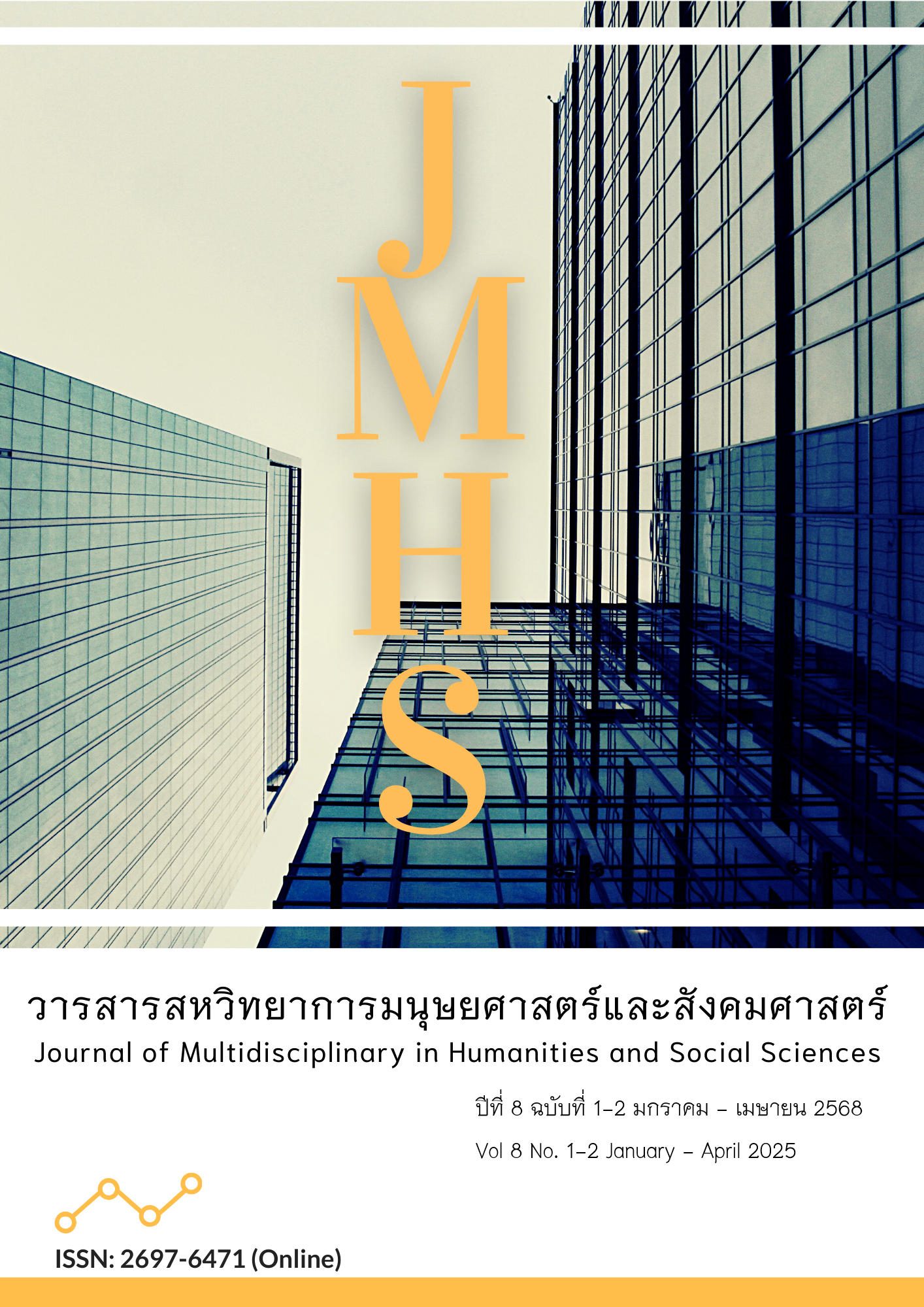The Components of Human Resource Development Strategies in Educational Institutions in the Digital Age
Main Article Content
Abstract
This article aimed to 1) study the components of human resource development strategies in educational institutions in the digital age under the jurisdiction of the Secondary Educational Service Area Office Bangkok 2 and 2) analyze confirmatory components related to human resource development strategies in educational institutions in the digital age under the jurisdiction of the Secondary Educational Service Area Office Bangkok 2 using mixed-method research. The study will explore concepts related to human resource development in digital-age educational institutions. The population and sample will consist of 350 teachers and educational personnel, selected through stratified sampling according to the proportion of teachers and personnel in the institution. Data will be collected using interviews and questionnaires. The statistics used for data analysis will include percentages, means, standard deviations, and data from confirmatory factor analysis, and the findings will be presented in descriptive narrative form.
The research results were found as follows: 1) The components of human resource development strategies in educational institutions in the digital age consist of seven components: needs assessment, individual development, professional development, organizational development, evaluation, performance management, supervision, and monitoring. 2) The analysis of the second-order confirmatory factor model of the components of human resource development strategies in educational institutions in the digital age, after revisions, revealed that the component loading values ranged from .73 to .94, which were statistically significant at the .05 level for all components, with standard errors ranging from .09 to .12. Each component explained the variance of the human resource development components in digital age educational institutions between 53% and 88%, indicating that all seven components serve as indicators of the overall human resource development strategy components in digital age educational institutions.
Article Details

This work is licensed under a Creative Commons Attribution-NonCommercial-NoDerivatives 4.0 International License.
Views and opinions appearing in the Journal it is the responsibility of the author of the article, and does not constitute the view and responsibility of the editorial team.
References
กนิน แลวงค์นิล และ ชญาพิมพ์ อุสาโห. (2562). แนวทางการพัฒนาสมรรถนะของครูใหม่สังกัดสำนักงานเขตพื้นที่การศึกษามัธยมศึกษา เขต 2 ตามแนวคิดการพัฒนาครูโดยโรงเรียนเป็นฐาน. วารสารการบริหารและนวัตกรรมการศึกษา, 2(1), 1-19. สืบค้นจาก https://so01.tci- thaijo.org/index.php/emi/article/view/134011
จตุรงค์ สุวรรณแสง. (2564) การบริหารความขัดแย้งของผู้บริหารสถานศึกษาในศตวรรษที่ 21 สังกัดสำนักงานเขตพื้นที่การศึกษามัธยมศึกษาเขต 2. วารสารการบริหารและนวัตกรรมการศึกษา, 4(1), 1-19. สืบค้นจาก https://so01.tci-thaijo.org/index.php/emi/article/view/240185
จอมพงศ์ มงคลวนิช. (2555). การบริหารองค์การและบุคลากรทางการศึกษา. กรุงเทพฯ: จุฬาลงกรณ์มหาวิทยาลัย.
เชาวลิต ยิ้มแย้ม, สายันต์ บุญใบ และ ชรินดา พิมพบุตร. (2566). ความต้องการจำเป็นและแนวทางการพัฒนาการดำเนินงานระบบดูแลช่วยเหลือนักเรียนของโรงเรียนขยายโอกาสทางการศึกษา สังกัดสำนักงานเขตพื้นที่การศึกษาประถมศึกษาสกลนคร เขต 1. วารสารการบริหารการศึกษาและภาวะผู้นำ มหาวิทยาลัยราชภัฏสกลนคร, 11(44), 103-113. สืบค้นจาก https://jeal.snru.ac.th/ArticleView?ArticleID=1308
โชติชวัล ฟูกิจกาญจน์. (2556). กระบวนการพัฒนาทรัพยากรมนุษย์เชิงกลยุทธ์. วารสารมนุษยศาสตร์และสังคมศาสตร์, 4(1), 33-45. สืบค้นจาก https://so02.tci-thaijo.org/index.php/human_ubu/article/view/85398
ดวงรัตน์ ธรรมสโรช, มะกือตา หะยีแวสอเหาะ, ซูลกิฟลี สะอิ, ซอมะ มีสา และ รัสรินทร์ฐิติวัชร์ฐากุล. (2567). ปัจจัยการติดต่อสื่อสารในองค์กรที่ส่งผลต่อกระบวนการบริหารทรัพยากรมนุษย์ของเทศบาลเมืองสระบุรี. วารสารรัชต์ภาคย์, 18(57), 398-414. สืบค้นจาก https://so05.tci-thaijo.org/index.php/RJPJ/article/view/270439
เดชา เดชะวัฒนไพศาล. (2566). การพัฒนาองค์การ (Organization development). กรุงเทพฯ: จุฬาลงกรณ์มหาวิทยาลัย.
ธรพรรธ อนุเวช และ พชรวิทย์ จันทร์ศิริสร. (2564). แนวทางการสร้างเสริมแรงจูงใจในการปฏิบัติงานของครู ในสังกัดสำนักงานเขตพื้นที่การศึกษามัธยมศึกษาร้อยเอ็ด. วารสารมหาจุฬานาครทรรศน์, 8(7), 185-198. สืบค้นจาก https://so03.tci-thaijo.org/index.php/JMND/article/view/253517
นิสดารก์ เวชยานนท์. (2559). การบริหารทุนมนุษย์เชิงกลยุทธ์เพื่อเพิ่มมูลค่า. กรุงเทพฯ: เดอะ กราฟิโก ซิสเต็มส์.
ประวิต เอราวรรณ์. (2562). การวิจัยและพัฒนาองค์การในโรงเรียน. กรุงเทพฯ: จุฬาลงกรณ์มหาวิทยาลัย.
พงศ์เทพ พรมตรุษ และ ฉลอง ชาตรูประชีวัน. (2564). การศึกษาความต้องการจำเป็นในการพัฒนาการจัดการเรียนรู้ของครูโรงเรียนในสังกัดสำนักงานเขตพื้นที่การศึกษาประถมศึกษาสุโขทัย เขต 1. Journal of Roi Kaensarn Academi, 7(7), 225-237. สืบค้นจาก https://so02.tci-thaijo.org/index.php/JRKSA/article/view/255168
พิชามญฐ์ แซ่จั่น. (2567). องค์ประกอบการบริหารทรัพยากรมนุษย์ของโรงเรียนมัธยมศึกษาตามยุทธศาสตร์ชาติ 20 ปี. วารสารนวัตกรรมการศึกษาและการวิจัย, 8(2), 811-827. สืบค้นจาก https://so03.tci-thaijo.org/index.php/jeir/article/view/273202
พิทยา บวรวัฒนา. (2558). ทฤษฎีองค์การสาธารณะ. กรุงเทพฯ: จุฬาลงกรณ์มหาวิทยาลัย.
พิมพันธ์ เตชะคุปต์. (2565). สมรรถนะการนิเทศเชิงรุก ชุมชนแห่งการเรียนรู้ทางวิชาชีพ. กรุงเทพฯ: จุฬาลงกรณ์มหาวิทยาลัย.
พิสมัย สิมสีพิมพ์. (2565). การพัฒนาศักยภาพครูในการจัดการเรียนรู้เชิงรุกโรงเรียนบ้านน้ำพ่น สังกัดสำนักงานเขตพื้นที่การศึกษาประถมศึกษาอุดรธานี เขต 1. วารสารวิชาการมหาวิทยาลัยราชภัฏศรีสะเกษ, 16(1), 135-147. สืบค้นจาก https://so05.tci-thaijo.org/index.php/sskrujournal/article/view/253904
เพ็ญจันทร์ สินธุเขต. (2560). การศึกษายุคนี้ (ยุคดิจิทัล): Thailand 4.0. ใน การประชุมวิชาการระดับชาติ คณะครุศาสตร์ มหาวิทยาลัยราชภัฏลำปาง ครั้งที่ 3. สืบค้นจาก http://www.thaischool1.in.th/_files_school/36108376/workteacher/36108376_1_20170724- 220005.pdf
มธุรส จิตรโรจนรักษ์. (2566). การพัฒนาทรัพยากรมนุษย์ของโรงเรียนวัดหนองจิก สำนักงานเขตพื้นที่การศึกษาประถมศึกษา นครปฐม เขต 1. วารสารปรัชญาปริทรรศน์. 28(2), 223-235. สืบค้นจาก https://so05.tci-thaijo.org/index.php/phiv/article/view/261962/181185
ลภัสพร วงศ์เมฆ. (2564). การพัฒนาการบริหารงานวิชาการของหัวหน้ากลุ่มสาระการเรียนรู้ สหวิทยาเขตสุราษฎร์ธานี 2 สำนักงานเขตพื้นที่การศึกษามัธยมศึกษาสุราษฎร์ธานี ชุมพร. วารสารวิชาการสถาบันอาชีวศึกษาภาคใต้ 1. 6(1), 23-31. สืบค้นจาก https://ph01.tci-thaijo.org/index.php/csnp_veis1/article/view/244270
ลักษณา ศิริวรรณ. (2560). การพัฒนาทรัพยากรมนุษย์ (Human Resource Management). กรุงเทพฯ: มหาวิทยาลัยสุโขทัยธรรมาธิราช.
วรารัตน์ เขียวไพรี. (2551). การพัฒนาทรัพยากรมนุษย์ในองค์การ. กรุงเทพฯ: มหาวิทยาลัยราชภัฏธนบุรี.
วัชระ ขาวสังข์. (2560). การจัดการทรัพยากรมนุษย์. ยะลา: มหาวิทยาลัยราชภัฎยะลา.
วีรวิชญ์ ปิยนนทศิลป์. (2561). การพัฒนาพื้นที่ชายแดน เพื่อการค้าการลงทุนและการยกระดับคุณภาพชีวิตของประชาชน. วารสารมหาวิทยาลัยพายัพ, 27(2), 1-11. สืบค้นจาก https://so05.tci-thaijo.org/index.php/pyu/article/view/123264
ศรันย์ดิษฐ์ เบญจพงศ์. (2562). โฉมหน้าการบริหารผลการปฏิบัติงาน. นครสวรรค์: มหาวิทยาลัยเจ้าพระยา.
ศิรภัสสรศ์ วงศ์ทองดี. (2559). การพัฒนาทรัพยากรมนุษย์ (Human Resource Development). กรุงเทพฯ: จุฬาลงกรณ์มหาวิทยาลัย.
สงบ อินทรมณี. (2562). การบริหารสถานศึกษาในยุคดิจิทัล. วารสารวิชาการ มหาวิทยาลัยการจัดการและเทคโนโลยีอีสเทิร์น, 16(1), 353-360. สืบค้นจาก https://so06.tci-thaijo.org /index.php/umt-poly/article/view/192507
สัจจา เจริญศรีเมือง, ปิยาภรณ์ พิชญาภิรัตน์ และ อรธิดา ประสาร. (2567). การพัฒนารูปแบบการนิเทศเพื่อเสริมสร้างสมรรถนะการจัดการเรียนรู้โดยใช้นวัตกรรมเป็นฐาน ของครูโรงเรียนนำร่องพื้นที่นวัตกรรมการศึกษา. วารสารศิลปการจัดการ, 8(2), 428-444. สืบค้นจาก https://so02.tci-thaijo.org/index.php/jam/article/view/270638
สำนักงานเลขาธิการสภาการศึกษา. (2565). มาตรการบริหารจัดการกำลังคนภาครัฐ (พ.ศ. 2566-2570). กรุงเทพฯ: กระทรวงศึกษาธิการ.
สำนักนโยบายและยุทธศาสตร์ สป.ศธ. (2567). นโยบายและจุดเน้นของกระทรวงศึกษาธิการ ประจำปีงบประมาณ พ.ศ. 2567. สืบค้นจาก https://www.moe.go.th/360policy-and-focus-moe-fiscal-year-2024/
สุกัญญา แช่มช้อย. (2562). การบริหารสถานศึกษาในยุคดิจิทัล. กรุงเทพฯ: จุฬาลงกรณ์มหาวิทยาลัย.
อัลยานี วาโดร์ และ โอภาส เกาไศยาภรณ์. (2561). การพัฒนารูปแบบการแลกเปลี่ยนเรียนรู้ผ่านเว็บบล็อกตามแนวคิดเพื่อนช่วยเพื่อน เรื่องการวิจัยในชั้นเรียนสำหรับครูผู้สอน สังกัดสำนักงานเขตพื้นที่การศึกษาประถมศึกษาปัตตานี เขต 3. วารสารวิทยบริการ มหาวิทยาลัยสงขลา-นครินทร์, 29(2), 29-42. สืบค้นจาก https://journal.oas.psu.ac.th/index.php/asj/article/view/1128
เอกสิทธิ์ สนามทอง. (2562). การพัฒนาทรัพยากรมนุษย์: แนวทางพัฒนาสู่ความสำเร็จขององค์การ.วารสารเกษมบัณฑิต, 20(1), 64-77. สืบค้นจาก https://so04.tci-thaijo.org/index.php /jkbu/article/view/190409
Cimatti, B. (2016). Definition, Development, Assessment of Soft Skills and Their Role for the Quality of Organizations and Enterprises. International Journal for Quality Research, 10(1), 97-130. Retrieved from http://www.ijqr.net/journal/v10-n1/5.pdf
Delahaye, B. L. (2000). Human resource development: principles and practice. Singapore: John Wiley & Sons.
Donaldson, L., & Scannell, E. E. (2000). Human Resource Development: The new trainer’s guide. USA: Addison-Wesley Publishing Company.
Fisher, C.D., Schoenfeldt, L.F., & Shaw, J.B. (1996). An Introduction to Human Resource Management. Boston: Houghton Mifflin Company.
Gilley, J., Eggland, S., & Maycunich, A. (2002). Principle of Human Resource Development. Cambridge: Perseus.
Jackson, S. E., Schuler, R. S. & Werner, S. (2009). Managing Human Resource. Ohio: South Western Cengage Learning.
Jacobs, R. L. (2014). System Theory and HRD in Handbook of Human Resource Development. New Jersey: John Wiley & Sons.
Lim, G. S., Werner, J. M., & Desimone, R. L. (2013). Human Resource Development for Effective Organizations: Principles and Practices across National Boundaries. Singapore: Cengage Learning Asia.
Majid, S., Liming, Z., Tong, S., & Raihana, S. (2012). Importance of Soft Skills for Education and Career Success. International Journal for Cross-Disciplinary Subjects in Education (IJCDSE), 2(2), 1036-1042. DOI:10.20533/ijcdse.2042.6364.2012.0147
Nadler, L. (1970). Developing human resource. Houston: Gulf Publishing Company.
Noe, R. A. (2013). Employee Training and Development. Singapore: McGraw-Hill.
Pace, W. R., Smith, P. C., & Mills, G. E. (1991). Human Resource Development: The Field. Englewood Cliffs: Prentice Hall.
Swanson, R. A., & Holton, E. F. (2001). Foundation of human resource development. San Francisco: Berrett-Koehler Publishers.
Woolner, P. (1992). The purposes and stages of the learning organization. Thresholds in education, 9(23), 41–46. Retrieved from https://academyforeducationalstudies.org/wp-content/uploads/2015/09/1992completethrvol18no2-3.pdf

